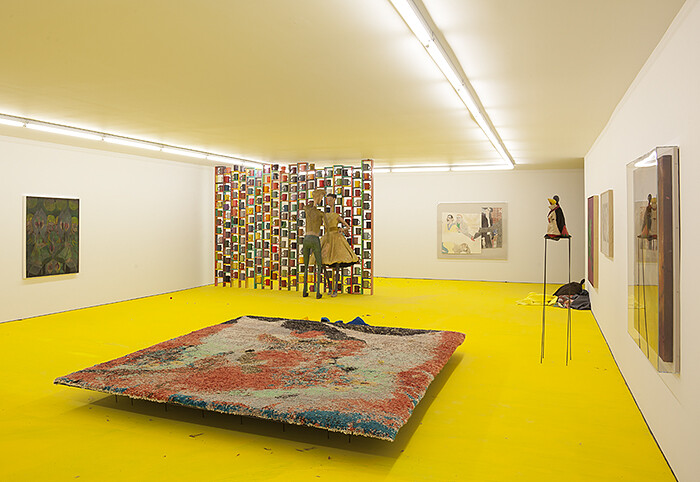There’s something slightly strange about walking into an installation designed to look like a homemade living room in every way but the lighting. In the case of Kai Althoff at Gladstone Gallery, the cement floor painted bright yellow doesn’t exactly scream domesticity either, but the artist has integrated enough interior design elements that the florescent lights hanging from the lowered ceiling is disconcerting. Why arrange a raised nappy rug, a series of paintings in the style of Otto Dix and George Grosz, and a dividing wall of painted plaster mugs as if they were part of a household if they are to be lit like a gallery object in… a Subway sandwich store?
The answer to this question doesn’t come from the gallery’s press release, which is purely descriptive, but from the objects themselves: everything is a half-revealed mystery; a personal or private act made kind-of public. The results of such arrangements are predictably mixed. Take the references to religion scattered throughout the show: a watercolor portrait of a Jewish man hangs in the main exhibition space, and in a semi-private corner there is a pile of objects presumably used for worship. We never learn what the artist’s relationship to religion is; only that one exists.
This is a rather banal take on religion, but since the works contextualize other objects in the show, it’s probably worth looking past. There’s no apparent purpose for the red velvet curtains creating a hallway from one part of the exhibition to the next, for example, but the veneer of religion elsewhere leaves a viewer thinking about spirituality, magic, and the inside of a body. It also reminded me of film—I spent a significant amount of time trying to find a way to pull the curtains aside so I could enter what I believed to be a video room before a guard finally told me there was nothing there. Needless to say, I’m not sure the fabric is a huge success.
Inside the smaller room, a couple made of discarded clothing appears to either be having sex on a chair or to have just finished. A darkly colored painting in which only a partial face can be discerned hangs behind the couple, and a look inside a small ventilation shaft reveals a heart shaped valentine made of felt. Here, desire is not only more visible than emotions, but entirely disconnected from the body.
This is a nice touch in a surreal exhibition filled with objects that despite their handmade touch seem a little impersonal and distant. Even the two flirting figures crafted from plaster in the larger room don’t seem imbued with more than just tepid desire. While ultimately I appreciate the tension Althoff creates by shining a bright light on objects that remain aloof, I do so only because Althoff wasn’t a complete masochist about it. Tenderness, even if it ends up stuffed in a ventilation shaft, can never truly be erased.





